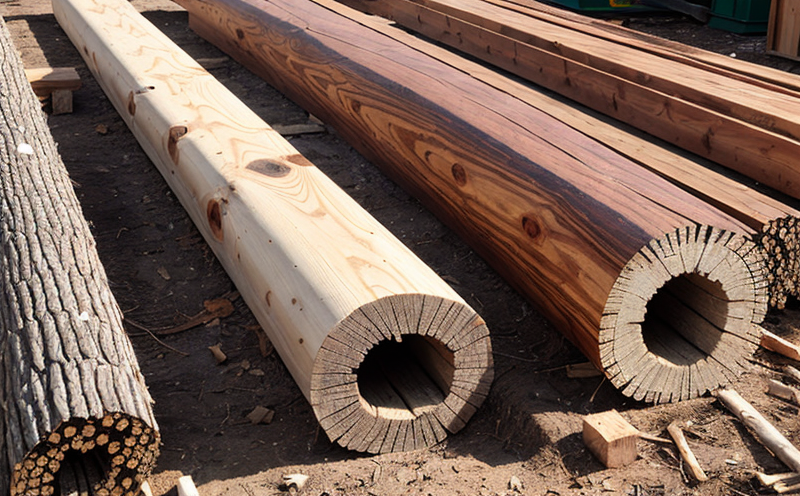Paint & Coating Compatibility Testing on Treated Wood
The integrity and longevity of wood structures are often compromised by environmental factors such as moisture, UV radiation, and biological attacks. To mitigate these risks, wood is frequently treated with preservatives, biocides, or other protective chemicals. However, the performance of coatings applied to this treated wood can be significantly influenced by the underlying treatment process. This service focuses on evaluating the compatibility between paint, varnish, or other coating materials and chemically modified wood. By ensuring that both the treated wood substrate and the applied coating perform optimally together, we help our clients achieve durable, aesthetically pleasing, and environmentally sustainable wooden structures.
The testing process involves a series of standardized procedures that simulate real-world conditions to assess the interaction between paint or coating and chemically modified wood. This includes evaluating factors such as adhesion strength, resistance to moisture absorption, flexibility under stress, and overall durability over time. Compliance with international standards like ISO 16123:2017 (Paints and varnishes -- Compatibility of coatings with substrates) is crucial for ensuring accurate results.
During specimen preparation, the wood samples are treated according to specified protocols before being coated with various types of paint or coating. The specimens are then subjected to a range of environmental stress tests, including exposure to high humidity and temperature cycles, UV radiation, salt spray, and immersion in water. This allows for the assessment of how well the paint adheres to the wood surface while maintaining its protective qualities.
The results from these tests provide valuable insights into the performance characteristics of different coatings on chemically treated wood substrates. These findings can help manufacturers make informed decisions about which paints or coatings are best suited for specific applications, ensuring that they meet regulatory requirements and customer expectations regarding longevity and appearance.
Our laboratory utilizes advanced analytical techniques such as Fourier Transform Infrared Spectroscopy (FTIR), X-ray Diffraction (XRD), and Scanning Electron Microscopy (SEM) to analyze the molecular structure of both the wood sample and the applied coating. These analyses help identify any potential issues with adhesion or chemical interactions between the two materials. Additionally, we use mechanical testing machines capable of applying controlled forces and measuring deformation rates, providing quantitative data on the physical properties of the coated specimens.
Standardization is key in this process; therefore, adherence to recognized international standards such as ASTM D4236-18 (Standard Test Method for Evaluating Paint and Varnish Compatibility with Wood Substrates) ensures consistency across all tests conducted here. This guarantees that our clients receive reliable, reproducible data which can be used confidently when making strategic decisions regarding their products.
Benefits
- Ensures optimal performance and longevity of painted or coated wood structures.
- Avoids premature degradation due to poor compatibility between coating materials and chemically treated substrates.
- Saves time and resources by preventing costly mistakes in material selection early in the development stage.
- Facilitates compliance with industry standards and regulatory requirements, enhancing product reliability.
Competitive Advantage and Market Impact
- Pioneers cutting-edge methodologies for assessing compatibility between paint/coatings and treated wood substrates.
- Gains competitive edge by offering unparalleled expertise in analyzing complex interactions within composite materials.
- Aids businesses in achieving sustainable growth through improved product quality and enhanced customer satisfaction.
Use Cases and Application Examples
| Application Example | Description | Test Parameters |
|---|---|---|
| Fence Rail Protection | Testing the durability of a new wood preservative on fence rails before finalizing its formulation. | Moisture absorption rates, adhesion strength under UV exposure. |
| Outdoor Furniture Finish | Evaluating a newly developed varnish for outdoor furniture against salt spray resistance and color retention after immersion. | Salt spray testing, UV radiation tests, color change measurement. |
| Application Scenario | Description | Testing Protocols |
|---|---|---|
| Deck Flooring Finishing | Determining the best coating for deck flooring to withstand frequent foot traffic and weather conditions. | Load-bearing capacity tests, slip resistance measurements. |
| Wall Cladding Protection | Assessing a new eco-friendly wood preservative on wall cladding for its effectiveness against mold growth and fungi. | Mold growth inhibition tests, fungal colony count reduction. |





